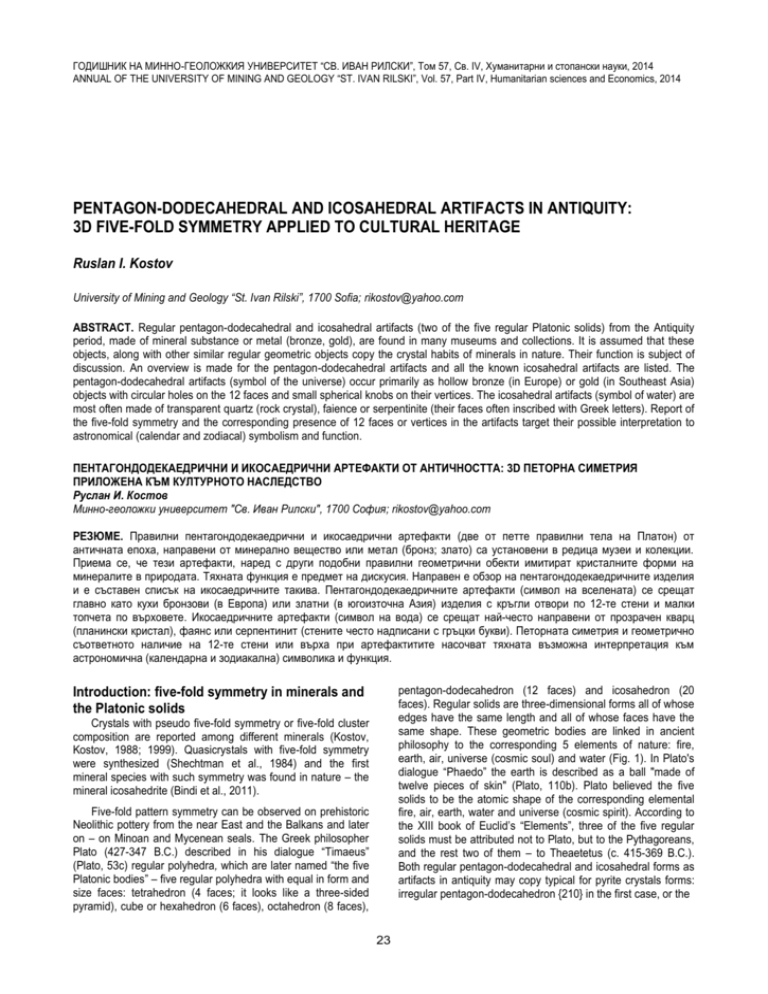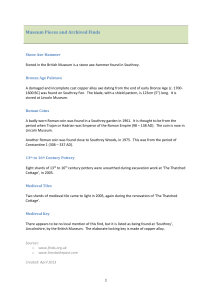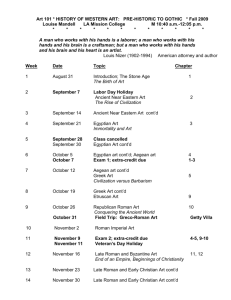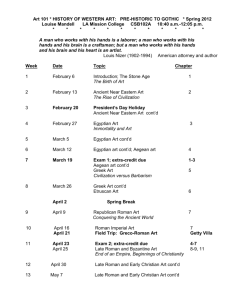ГОДИШНИК НА МИННО-ГЕОЛОЖКИЯ УНИВЕРСИТЕТ “СВ
advertisement

ГОДИШНИК НА МИННО-ГЕОЛОЖКИЯ УНИВЕРСИТЕТ “СВ. ИВАН РИЛСКИ”, Том 57, Св. IV, Хуманитарни и стопански науки, 2014
ANNUAL OF THE UNIVERSITY OF MINING AND GEOLOGY “ST. IVAN RILSKI”, Vol. 57, Part IV, Humanitarian sciences and Economics, 2014
PENTAGON-DODECAHEDRAL AND ICOSAHEDRAL ARTIFACTS IN ANTIQUITY:
3D FIVE-FOLD SYMMETRY APPLIED TO CULTURAL HERITAGE
Ruslan I. Kostov
University of Mining and Geology “St. Ivan Rilski”, 1700 Sofia; rikostov@yahoo.com
ABSTRACT. Regular pentagon-dodecahedral and icosahedral artifacts (two of the five regular Platonic solids) from the Antiquity
period, made of mineral substance or metal (bronze, gold), are found in many museums and collections. It is assumed that these
objects, along with other similar regular geometric objects copy the crystal habits of minerals in nature. Their function is subject of
discussion. An overview is made for the pentagon-dodecahedral artifacts and all the known icosahedral artifacts are listed. The
pentagon-dodecahedral artifacts (symbol of the universe) occur primarily as hollow bronze (in Europe) or gold (in Southeast Asia)
objects with circular holes on the 12 faces and small spherical knobs on their vertices. The icosahedral artifacts (symbol of water) are
most often made of transparent quartz (rock crystal), faience or serpentinite (their faces often inscribed with Greek letters). Report of
the five-fold symmetry and the corresponding presence of 12 faces or vertices in the artifacts target their possible interpretation to
astronomical (calendar and zodiacal) symbolism and function.
ПЕНТАГОНДОДЕКАЕДРИЧНИ И ИКОСАЕДРИЧНИ АРТЕФАКТИ ОТ АНТИЧНОСТТА: 3D ПЕТОРНА СИМЕТРИЯ
ПРИЛОЖЕНА КЪМ КУЛТУРНОТО НАСЛЕДСТВО
Руслан И. Костов
Минно-геоложки университет "Св. Иван Рилски", 1700 София; rikostov@yahoo.com
РЕЗЮМЕ. Правилни пентагондодекаедрични и икосаедрични артефакти (две от петте правилни тела на Платон) от
античната епоха, направени от минерално вещество или метал (бронз; злато) са установени в редица музеи и колекции.
Приема се, че тези артефакти, наред с други подобни правилни геометрични обекти имитират кристалните форми на
минералите в природата. Тяхната функция е предмет на дискусия. Направен е обзор на пентагондодекаедричните изделия
и е съставен списък на икосаедричните такива. Пентагондодекаедричните артефакти (символ на вселената) се срещат
главно като кухи бронзови (в Европа) или златни (в югоизточна Азия) изделия с кръгли отвори по 12-те стени и малки
топчета по върховете. Икосаедричните артефакти (символ на вода) се срещат най-често направени от прозрачен кварц
(планински кристал), фаянс или серпентинит (стените често надписани с гръцки букви). Петорната симетрия и геометрично
съответното наличие на 12-те стени или върха при артефактитите насочват тяхната възможна интерпретация към
астрономична (календарна и зодиакална) символика и функция.
Introduction: five-fold symmetry in minerals and
the Platonic solids
pentagon-dodecahedron (12 faces) and icosahedron (20
faces). Regular solids are three-dimensional forms all of whose
edges have the same length and all of whose faces have the
same shape. These geometric bodies are linked in ancient
philosophy to the corresponding 5 elements of nature: fire,
earth, air, universe (cosmic soul) and water (Fig. 1). In Plato's
dialogue “Phaedo” the earth is described as a ball "made of
twelve pieces of skin" (Plato, 110b). Plato believed the five
solids to be the atomic shape of the corresponding elemental
fire, air, earth, water and universe (cosmic spirit). According to
the XIII book of Euclid’s “Elements”, three of the five regular
solids must be attributed not to Plato, but to the Pythagoreans,
and the rest two of them – to Theaetetus (c. 415-369 B.C.).
Both regular pentagon-dodecahedral and icosahedral forms as
artifacts in antiquity may copy typical for pyrite crystals forms:
irregular pentagon-dodecahedron {210} in the first case, or the
Crystals with pseudo five-fold symmetry or five-fold cluster
composition are reported among different minerals (Kostov,
Kostov, 1988; 1999). Quasicrystals with five-fold symmetry
were synthesized (Shechtman et al., 1984) and the first
mineral species with such symmetry was found in nature – the
mineral icosahedrite (Bindi et al., 2011).
Five-fold pattern symmetry can be observed on prehistoric
Neolithic pottery from the near East and the Balkans and later
on – on Minoan and Mycenean seals. The Greek philosopher
Plato (427-347 B.C.) described in his dialogue “Timaeus”
(Plato, 53c) regular polyhedra, which are later named “the five
Platonic bodies” – five regular polyhedra with equal in form and
size faces: tetrahedron (4 faces; it looks like a three-sided
pyramid), cube or hexahedron (6 faces), octahedron (8 faces),
23
Fig. 1. The five Platonic solids in Johannes Kepler’s “Harmonices Mundi”, Book II (1619), according to ancient Greek philosophy (used in
his geometric cosmology)
combination of octahedron {111} and irregular pentagondodecahedron {210} – in the second case (Kostov, 1993). The
rest Platonic bodies as artifacts may also have some
corresponding to crystal habits of minerals shape, for example:
tetrahedrite for the tetrahedron; magnetite, fluorite and
diamond – for the octahedron; pyrite, galena, halite and fluorite
– for the cube or hexahedron.
dice; with an as-part against a species of rod tapered tip
graduated on which would been drawn hallmarks; toys, without
specifying; masterpiece for control (measure) (de SaintVenant, 1907; cit. after Déonna, 1954). Additionally some other
hypothesis are listed: connection to the zodiac (Artmann,
1993); optical rangefinder for the army or dioptron (Sparavigna,
2012a; 2012b), clinometer (Meréaux-Tanguy, 1975) candle- or
flower stands, finger ring-size gauges or even a toy to throw
and catch on a stick or some sort of oracle.
In Scotland (mainly in Aberdeenshire) are found stone
rounded ornamented (cut with small knobs) balls with
geometric patterns, some of them corresponding to the
Platonic bodies and also with a 5-fold symmetry (including
dodecahedron with 12 faces, a form with two opposite
hexagons, each surrounded by six pentagons with 14 faces
and icosahedron with 20 faces). For example, the Ashmolean
Museum at Oxford University exhibits five different rounded
stones with regularly spaced bumps. All these balls are dated
from the Late Neolithic to Bronze Age (~II-I mill. B.C.; predating
Plato) and their number is estimated between four-five hundred
specimens (Mann, 1914; Marshall, 1976/77; 1983). The high
points of each bump mark the vertices of each of the regular
polyhedra. It has been conjectured that such artifacts were
used: (1) in some sort of game or for amusement, (2) for
magical or religious ceremonies, (3) mounted or tied to rods
and used as weapons (stone mace) or (4) as trade weights.
Fig. 2. Examples of “Roman dodecahedron” (de Saint-Venant,
1907, pl. 1: left – from Reims N38; right from Membrey N26)
The earliest dodecahedra, dated about 500 B.C., made
from stone (soapstone – steatite), are supposed to be of an
Etruscan origin (Lindemann, 1896, cit. after Artmann, 1993). In
a single case, in Switzerland (Geneva), a silver pentagondodecahedron with lead core has been found and described,
the faces inscribed with the 12 zodiacal names (Cervi-Brunier,
1985).
Pentagon-dodecahedral artifacts
In several mainly west and central Europeans countries
(United Kingdom, Belgium, France, Germany, Luxembourg,
The Netherlands, Switzerland, Italy, Austria, Hungary and
Croatia, with the greatest number discovered in the west of
Germany and in France), during archaeological research, are
found bronze hollow dodecahedra (from a crystallographic
point of view – regular pentagon-dodecahedra) related in age
to Roman times, their number estimated above 100 samples
(de Saint-Venant, 1907; Saint-Michel, 1951; Déonna, 1954;
Duval, 1981; Artmann, 1993; Hill, 1994; Nouwen, 1994;
Guggennberger, 2000; 2013; with corresponding therein
references; Fig. 2; Table 1A). They have circular opening
usually of different diameter on each face of the artifact, as well
as small spherical knobs on their vertices. Also, in most cases
on the faces are observed small incised concentric circles,
arranged around the circular hole. The size of the artifacts
varies 4-11 cm. Their purpose and utilization is under
discussion: for example – heads of scepters, or sticks of
command; heads of maces; linings sprinklers; chandeliers for
candles of various sizes; gauge measuring cylinders of various
sizes; caliber for coin blanks; instrument for playing, a kind of
Metallic gold pentagon-dodecahedral artifacts are
discovered in south-east Asia. The polyhedral gold bead from
Khao Sam Kaeo, in eastern peninsular Thailand, is stylistically
identical to those from Oc Eo in the Mekong Delta (Vietnam),
and to numerous similar beads from other Pyu sites in
Myanmar (Bennett, 2009). Several of the gold ornaments
recorded in private collections around Khao Sam Kaeo,
including the characteristic pentagonal polyhedral gold beads,
have also been found in local private collections and also bear
strong similarities to the finds from Oc Eo (because of the 12
faces, they are supposed to be linked to some sort of
astronomical or astrological significance; Spagnoli, 2004).
In some cases, the dodecahedra are made of solid rock or
mineral, as in the case with the artifact in the Varna
Archaeological Museum in Bulgaria (probably a Roman die;
together with another cubic and typical to Roman times bone
die on display; Haralambieva, 2006).
24
Table 1. Regular pentagon-dodecahedral (A) and icosahedral (B) as artifacts in Antiquity (data from references and Internet)
Country/Region
Museum
Age
Notes
Material/Size
A
Italy
1000-900 B.C. or Etruscan; Monte Loffa, with soapstone
~500 B.C.
markings on the faces
Italy
Perugia, Museum of ~5-4 c. B.C.
Etruscan; mounted on bronze bronze
(2 samples)
Antiquities
sticks
Europe
>100 samples
1st - 4th c.
Roman period; hollow;
bronze
Switzerland
Geneva,
Cathédrale 3rd-4th c.
Roman; Genf, inscribed silver; lead core; 297
Saint-Pierre
zodiacal signs
grammes
USA
Arthur
M.
Sackler c. 300-500
Roman; inscribed letters
garnet; 5.6 cm
Museum; 1992.256.199
France
Troyes, Musée
Roman times
France; incised figures in bone
Latin count (I to XII)
Bulgaria
Varna, Historical Museum Roman times
Roman die
stone; ~3 cm
SE Asia
5th c. B.C- 5th c.
Mekong River; other places
gold
France
Musée Guimet
2nd c.
Southern China; hollow beads gold (2 samples)
B
Germany
Bonn,
Rheinisches Roman times
Arloff, hollow
bronze; ~8 cm
Landesmuseum
Sweden
Stockholm,
Ptolemaic Period
Egypt: Ptolemaic Period - faience, brown (?);
Medelhavsmuseet
Roman Period; inscribed with stone, glazed (?); stone
Greek letters
France
Paris, Louvre; I 1532
323-30 B.C.
Egypt: Ptolemaic Period - steatite
Roman Period; inscribed with
Greek letters
USA
New
York,
The 2nd c. B.C.–4th c. Egypt: Ptolemaic Period - serpentine; 2.7 x 3 x 2.8
Metropolitan Museum of
Roman Period; inscribed with cm
Art; 10.130.1157
Greek letters
USA
New
York,
The 2nd c. B.C.–4th c. Egypt: Ptolemaic Period - serpentine; 3.2 x 3.8 x
Metropolitan Museum of
Roman Period; inscribed with 3.4 cm
Art; 10.130.1158
Greek letters
USA
New
York,
The 2nd c. B.C.–4th c. Egypt: Ptolemaic Period - faience; 4.5 x 4.9 x 4.7
Metropolitan Museum of
Roman Period; inscribed with
Art; 10.130.1159
Greek letters
USA
New
York,
The 2-3 c.
Roman; inscribed with Greek faience; green, 6.2 cm
Metropolitan Museum of
letters
Art; MMA 37.11.3
Egypt
Kharga, New Valley 1st c. (?)
Egypt;
Dakhleh
Oasis; limestone; 5x6 cm
Museum; inv. N843
inscribed with Egyptian divine
names in Demotic letters
Egypt
Cairo museum
Egypt; inscribed with Greek steatite or faience
(2 icosahedra)
letters
United Kingdom
London, British Museum; Greco-Roman
Egypt; inscribed with Greek faience,
serpentine,
(4 icosahedra)
EA 59732;
period
letters (1 pink; 1 greenish, 2 steatite, and/or calcite
AES 1911.0617.40
brown)
[Christie’s; 2003]
1st/2nd c.
Egypt; inscribed with signs
faience, green; 5.2 cm
United Kingdom
Birmingham, University of Greek die; inscribed with stone, brown; 5.2x5.7
Birmingham; ECM552
Greek letters
cm
United Kingdom
London, British Museum
1st c.
inscribed with Greek letters
stone; ~7.62 cm
United Kingdom
London, British Museum;
1st/2nd c.
Roman; inscribed on 2 faces rock crystal; 1.7x1.5 cm
GR 1923.0401.1184
with X and I
France
Paris, Louvre
Egypt; inscribed with Latin rock crystal
letters and Roman numerals
France (Corsica)
Aléria, Museum
Roman
rock crystal
Italy
Arezzo,
State 1st c.
Roman; feminine grave near rock crystal; ~2.8-3.0
Archaeological Museum
Arezzo
cm
Turkey
Istanbul Art Museum
Greek or Roman
rock crystal
Serbia
Belgrade
3rd c.
Roman, Castrum Novae
rock crystal; 5.5x4.7cm
SE Asia
5th c. B.C- 5th c.
Mekong River; other places
gold
25
Rock crystal deformed (irregular) pentagon-dodecagonal
spindle whorls (?) of the Merovingian period (6th century) are
known from: Rhenen Donderberg grave 413 (Leiden Rh 413),
fitted on to a Carolingian bone spindle rod from Dorestad,
Leiden; Alfriston grave 65, c. 500-560, Lewes Castle Museum
(hexagons and not pentagons on the two opposite sides); and
from Jerusalem, “Tomb of the Prophets” (Merovingian?), BM
49/11-27/13. Most of the initial pentagon faces display
additional facets forming trigonal and tetragonal faces,
probably after a new faceting (see also Babelon, 1902; p. 11,
Fig. 8, Mayence museum).
black dice with two of four corners marked in white are known
from Mesopotamia.
Conclusions
The pentagram as a single side of a pentagonal
dodecahedron is closely associated with the so-called golden
section, which the ancient Greeks believed to have powerful
mystical and aesthetic properties both. The dodecahedron was
a form with enormous significance for the Neo-Pythagoreans
as representation of the atomic shape of the universe (or
cosmic spirit), with the twelve pentagonal faces corresponding
to the signs of the zodiac. Most researchers accept the
hypothesis that the ancient bronze dodecahedra were ritual or
oracle tools, on occasion used as divinatory dice.
Icosahedral artifacts
Artifacts with five-fold symmetry displaying isosahedral
habit (morphology) are known also in Antiquity. They are made
mainly from rock crystal and faience (Western and Central
Europe; Roman Empire) or serpentinite (Egypt; Ptolemaic
Egypt – Roman times) (Table 1B).
The existing and new lists of pentagon-dodecahedral and
icosahedral artifacts, as well as new finds, are base for further
on study on the utilization of these objects both from a practical
and philosophical point of view: comparison of European and
Asian cases; five-fold symmetry symbolism in different
religious systems; calendar and zodiacal importance.
A unique icosahedron was found at Qaret el-Muzzawaqa in
the 1980s and is now housed in the New Valley Museum at
Kharga (probably dated to the 1st century). In contrast to other
icosahedra, known from Graeco-Roman Egypt, this one is not
inscribed with Greek or Latin letters or numbers, but with 20
Egyptian divine names in Demotic, thus adapting Egyptian
concepts to a Greek form. The piece provides striking evidence
for the mixing of cultural traditions in Dakhleh Oasis in the
Roman Period. The polyhedron was presumably used in an
oracular procedure intended to establish which deity would
provide help to the petitioner (Minas-Nerpel, 2007).
The main material for the pentagon-dodecahedral hollow
artifacts is metal (bronze in the European area in Roman times
and gold in South-East Asia). As an analog to the symbolism of
the five Platonic bodies, the element “wood” is among the 5
major elements in Chinese philosophy and Feng Shui systems
with corresponding green colour.
The main material for the icosahedral artifacts is quartz
(transparent rock crystal), faience and probably serpentine.
The icosahedral form corresponds to the element “water” in
both Greek and Eastern symbolic systems. Water is
symbolized by clear quartz (rock crystal).
Of interest is the rock crystal icosahedron, found in SE
Europe at the Roman town Castrum Novae (dated from the
reign of emperor Septimius Severus to the last third of the 3rd
century) at Čezava (Vasić, 1992). The quartz icosahedron is
interpreted as a magical object, related to the corresponding
philosophical and mystical teachings (including the NeoPythagoreans) from the end of the 2nd and beginning of the 3rd
century. Similar rock crystal artifacts are known from some
other places and museums (Table 1B).
The close resemblance of irregular pentagon-dodecahedral
yellow pyrite crystal with metallic luster to the bronze or gold
regular dodecahedral artifacts is evidence that ancient people
tried to copy nature. Thus, the clear water is symbolized by
rock crystal, and the metallic shining pyrite crystals – by bronze
alloys or gold. The utilization of discussed artifact is open for
discussion with stress on their probable astronomical (calendar
and zodiacal) symbolism and significance.
A single case of Roman hollow bronze icosahedron is
known from Arloff (Bonn, Rheinisches Landesmuseum), also
with small spherical knobs on the vertices, as well as
concentric circles on the curvilinear triangular faces. Another
similar in shape metallic object, but from Medieval times, is a
gold icosahedral artifact from India, with gold letters on the
faces (on display by Sotheby).
References
Artmann, B. 1993. Roman dodecahedra. – The Math.
Intelligencer, 15, 2, 52-53.
Babelon, E. 1902. Histoire de la Gravure sur Gemmes en
France. Société de Propagation des Livres d'Art, Paris, IXX, 262 p., XXII pl.
Bennett, A. T. N. 2009. Gold in early Southeast Asia. –
ArchéoSciences, 33, 99-107.
Bindi, L., P. J. Steinhardt, N. Yao, P. J. Lu. 2011. Icosahedrite,
Al63Cu24Fe13, the first natural quasicrystal. – Amer.
Mineral., 96, 928-931.
Cervi-Brunier, I. 1985. Le dodécaèdre en argent trouvé à Saint
Pierre de Genève. – Zeitschrift für Schweizerische
Archäologie und Kunstgeschichte, 42, 3, 153-156.
de Saint-Venant, J. 1907. Dodécaèdres perlés en bronze creux
ajouré de l'époque gallo-romaine. Mazerou, Nevers, 52 p.
To the list of artifacts of regular pentagon-dodecahedral
and icosahedral shape (Table 1) one can add also the case
with an artifact from Ptolemaic Egypt with rhombic
dodecahedral form {111}, also inscribed with Greek letters (as
2 letters are on one face, this point to the representation of
numbers 1 to 12 by the letters in the Greek numeral system).
The {111} form is typical for garnet crystals and in certain
cases the shape of such artifacts may also copy minerals in
nature. Typical cubes from bone are more common among
Roman dice, but there are a few of them made of colourless
glass (from Cyprus; Metropolitan Museum of Art; MMA
74.51.332) or quartz (rock crystal; British Museum
1923,0401.1187; 1923,0401.1198). Rock crystal dice as a
combination of {100} and {111} forms are also known from the
British Museum (1886,0401.1718). Four sided (tetrahedral)
26
Déonna, W. 1954. Les dodécaèdres gallo-romaines, ajourés
et bouletés. A propos du dodécaèdre d'Avenches. –
Bulletin de l`Association Pro Aventico, 16, 18-89.
Duval, P.-M. 1981. Comment décrire les dodècaédres galloromaines en vue d'une étude comparée? – Gallia, 39, 2,
195-200.
Euclid. 1956. The Thirteen Books of the Elements. Vol. 3.
Books X-XIII. Dover, New York, 560 p.
Guggennberger, M. 2000. Etwas Gewisses hievon zu
bestimmen waere ein Gewagtes 260 Jahre DodekaederForschung. – Veröffentlichungen des Tiroler Landesmuseums Ferdinandeum, 80, 67-84.
Guggenberger, M. 2013. The Gallo-Roman dodecahedron. –
The Mathematical Intelligencer, 35, 4, 56-60.
Haralambieva, A. 2006. Horn and bone artifacts from the
Roman baths in Odessos. – Proc. People’s Museum
Varna, XLII (LXII), 39-63 (in Bulgarian).
Hill, C. 1994. Gallo-Roman dodecahedra: a progress report. –
The Antiquaries' Journal, 74, 289-292.
Kostov, I., R. I. Kostov. 1999. Crystal Habits of Minerals.
Bulgarian Academic Monographs, 1. Pensoft Publishers
and Prof. Marin Drinov Academic Publishing House, Sofia,
415 p.
Kostov, R. 1993. The pentagondodecahedron – Earth and
mineral dimensions. – Priroda [Nature], 42, 1, 52-58 (in
Bulgarian).
Kostov, R. I., I. Kostov. 1988. On the fivefold cluster symmetry.
– Cryst. Res. Technol., 23, 8, 973-977.
Lindemann, F. 1896. Zur Geschichte der Polyeder und der
Zahlzeichen. – Sitzungsber. der Math.-Phys. Klasse der
Kgl. Baierischen Akad. der Wiss., 26, 625-783.
Mann, L. M. 1914. The carved stone balls of Scotland: A new
theory as to their use. – Proc. Soc. Antiq. Scotland, 48,
407-420.
Marshall, D. N. 1976/77. Carved stone balls. – Proc. Soc.
Antiq. Scotland, 108, 40-72.
Marshall, D. N. 1983. Further notes on carved stone balls. –
Proc. Soc. Antiq. Scotland, 113, 628-646.
Meréaux-Tanguy, P. 1975. Le dodécaèdre: mesureur d’angle?
– Kadath, 13, 28-32.
Minas-Nerpel, M. 2007. A demotic inscribed icosahedron from
Dakhleh oasis. – The Journal of Egyptian Archaeology, 93,
1, 137-148.
Nouwen, R. 1994. Les dodécaèdres gallo-romains ajourés et
bouletés. Histoire et problèmes. – Bulletin de l'Institut
archéologique liégeois (BIAL), 106, 85-108.
Perdrizet, P. 1931. Le jeu alexandrine de l’icosaedre. – Bulletin
de l'Institut Français Arch. Orient., 30, 1-16.
Plato. 2008. Timaeus and Critias. Penguin Classics, 176 p.
Saint-Michel, L. 1951. Situation des dodécaèdres celtoromains dans la tradition symbolique pythagoricienne. –
Bulletin de l'Association Guillaume Budé: Lettres
d'humanité, 3 ser., 4, 92-116.
Shechtman, D., I. Blech, D. Gratias, J. W. Cahn. 1984. Metallic
phase with long-range orientational order and no
translational symmetry. – Physical Review Letters, 53,
1951-1953.
Spagnoli, M. 2004. Sui dodecaedri d’oro di Oc-èo. – AION, 64,
1-4, 247-255.
Sparavigna, A. C. 2012a. Come convertire una scatola di
carone in un telemetro. – Converter/& Cartotecnica, 86-88.
Sparavigna, A. C. 2012b. Roman dodecahedron as dioptron:
analysis
of
freely
available
data.
–
http://arxiv.org/ftp/arxiv/papers/1206/1206.0946.pdf
Vasić, M. 1992-1993. Icosahedron of quartz crystal from
Castrum Novae (Čezava). – Старинар [Starinar], XLIIIXLIV, 167-176.
Статията е рецензирана от проф. д-р Ат. Стаматов и препоръчана за
публикуване от кат. „Минералогия и петрография“.
27









